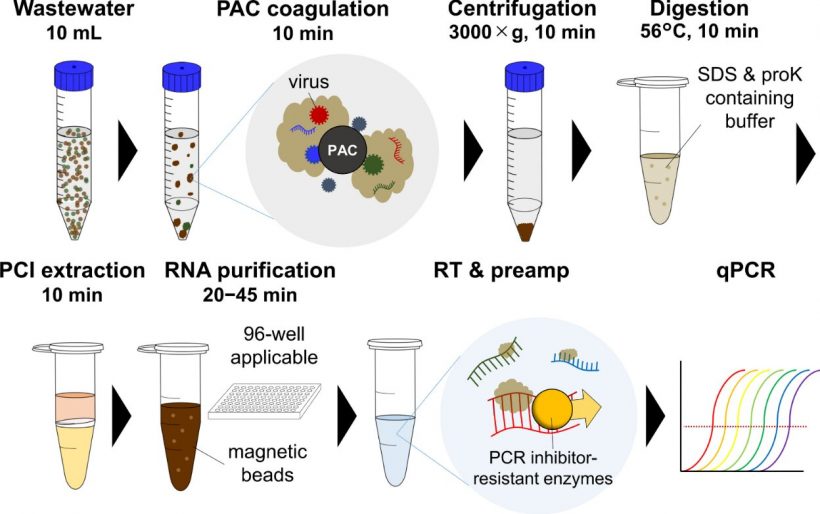
AdvanSentinel Inc., Shionogi & Co., Ltd., and Masaaki Kitajima, associate professor at the Faculty of Engineering, Hokkaido University have developed a highly sensitive detection technology for SARS-CoV-2 RNA in wastewater, in which most of the steps are compatible with automation.
Wastewater-based epidemiology is utilized as an effective tool to understand the prevalence of coronavirus disease 2019 (hereafter, “COVID-19”) at the population level, including asymptomatic and mildly symptomatic patients. Shionogi and Hokkaido University have been conducting collaborative research towards social implementation of wastewater-based epidemiology since October 2020. In regions where the prevalence of COVID-19 is low (such as Japan in the early phase of the pandemic), the virus concentration in wastewater is relatively low, making it difficult to quantitatively detect the viral RNA using conventional methods due to the lack of sensitivity.
One of the major aims of this collaborative research have been the development of a highly sensitive method for virus detection in wastewater that is essential for social implementation of wastewater-based epidemiology in Japan. Based on this background, the team recently reported the development of the EPISENS-S method, a highly sensitive and practical method for viral RNA detection in wastewater.
In addition, efforts are being made to establish an automated analysis system that can analyze a large number of samples, which is required for social implementation at the national level. Consequently, the team has successfully developed the COagulation and Proteolysis method using MAgnetic beads for detection of Nucleic acids in wastewater method (COPMAN method): a highly sensitive detection technology and suitable for automation. The study results have been published online in Science of the Total Environment on September 23, 2022.
The COPMAN method achieves rapid and stable virus recovery by using a coagulant in the virus concentration process from wastewater, which is expected to enable efficient detection of not only SARS-CoV-2 but also other viruses. It is expected that the dissemination of the COPMAN method will further accelerate the social implementation of wastewater-based epidemiology because a large number of samples can be analyzed by implementing this method with humanoid robots.

AdvanSentinel and Shionogi are making efforts with Hokkaido University in the technology development of wastewater-based epidemiology, which enables more accurate understanding of the prevalence of infectious diseases. We will contribute to an urgent issue, understanding of the prevalence of COVID-19 including variants, and continue to establish nation-wide wastewater surveillance systems to identify the public health threat and risk of possible next pandemic after COVID-19.
Details of study results
The COPMAN method developed in this study consists of the following steps: concentration of viruses in wastewater using a coagulant, extraction and purification of RNA using magnetic beads, and reverse transcription (RT)-preamplification-quantitative PCR (qPCR). The virus concentration step of the polyethylene glycol (PEG) precipitation method, the most widely used method used in Japan, takes more than 9 hours, whereas the use of a coagulant enables the COPMAN method to complete this step within just 10 minutes.
In addition, the method ensured the highly sensitive detection of viral RNA in wastewater by extracting RNA using a unique lysis buffer containing enzymes that degrade viral proteins in combination with a set of inhibitor-resistant enzymes in the RT-preamplification-qPCR step.
Using 12 municipal wastewater samples (i.e., influent wastewater collected at wastewater treatment plants) containing relatively low concentrations of viral RNA, we compared the COPMAN method with the PEG precipitation method and the ultrafiltration method for concentration, followed by conventional qPCR. The detection rate was 100% (12/12 samples) by the COPMAN method, which was much higher than those of PEG precipitation and ultrafiltration methods (17% (2/12 samples) and 42% (5/12 samples), respectively), demonstrating the high sensitivity of the COPMAN method.
The COPMAN method can also quantify pepper mild mottle virus (PMMoV) contained in feces, and thus SARS-CoV-2 RNA concentration can be normalized by the concentration of PMMoV (i.e, the influences of the fluctuation of the fecal load and dilution by rain water can be corrected).
While most of the SARS-CoV-2 in wastewater is associated with the solid fraction, many non-enveloped viruses including PMMoV are known to be present at a high proportion not only in the solid fraction but also in the liquid fraction. The COPMAN method can efficiently recover the virus in the liquid fraction in addition to that in the solid fraction in wastewater due to the use of the coagulant in the concentration step; in fact, PMMoV yield of the COPMAN method was higher than that of the EPISENS-S method, which only analyzes the solid fraction.

Thus, we consider that the COPMAN method is effective in detecting a variety of viruses including those abundantly present also in the liquid fraction like PMMoV and norovirus.
Source: Read Full Article
